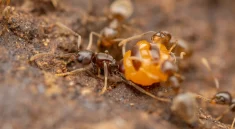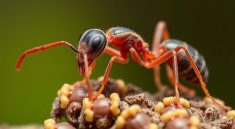Simple Machines Forum – Deep underground, where light never reaches, a silent engineering marvel is constantly at work. Ant colonies, those intricate societies of tireless workers, are far more than masters of survival—they are powerful environmental architects. Through their digging, farming, and waste recycling, ants shape entire microbial and carbon networks hidden beneath the soil. This natural engineering process, known as ant bioengineering, transforms how ecosystems store carbon, distribute nutrients, and sustain microbial diversity. It’s an invisible yet profound contribution to the planet’s ecological balance that scientists are only beginning to understand.
Table of Contents
Nature’s Most Underrated Engineers
The Science Behind Ant Bioengineering
How Ant Colonies Modify Soil Microbial Networks
Carbon Cycling Within Ant Ecosystems
The Role of Fungal and Bacterial Partners
Comparing Tropical and Temperate Ant Engineering
Environmental and Climate Implications of Ant Activity
Emerging Technologies for Studying Ant Ecosystems
How Ant Bioengineering Can Inspire Green Innovation
Frequently Asked Questions About Ant Bioengineering
The Ongoing Legacy of Earth’s Micro Architects
Nature’s Most Underrated Engineers

Ants have thrived for more than 100 million years, mastering the art of environmental manipulation. Every tunnel they carve and every chamber they construct creates tiny ecosystems rich in microbial life. This constant remodeling of the soil doesn’t just benefit their colony—it reshapes the physical and biological structure of entire habitats. The process known as ant bioengineering gives rise to air circulation channels, moisture pockets, and nutrient hotspots that fuel microbial activity.
Key ways ants influence the soil include:
-
Mixing organic and mineral layers through tunneling
-
Regulating humidity levels ideal for microbial survival
-
Creating microhabitats that encourage microbial diversity
By building and maintaining these environments, ants act as unseen bioengineers, ensuring the soil remains fertile, oxygenated, and alive.
The Science Behind Ant Bioengineering
Ant bioengineering is rooted in the concept of ecosystem engineering—organisms that modify their surroundings to create new ecological conditions. Through continuous movement, nest construction, and waste management, ants alter both physical and chemical soil properties. These modifications trigger changes in microbial communities responsible for decomposing organic material and cycling carbon.
Scientific insights show that ant colonies increase:
-
Soil porosity, allowing better water infiltration
-
Nutrient redistribution from surface litter to deeper layers
-
Microbial respiration and organic carbon stabilization
This interplay between ants and microbes forms a living feedback loop, balancing the soil’s carbon exchange and influencing the global carbon budget.
How Ant Colonies Modify Soil Microbial Networks
The structure of an ant nest acts as a blueprint for microbial organization. Each tunnel and chamber supports a distinct microbial community adapted to local conditions. Surface layers teem with aerobic bacteria, while deeper zones host anaerobic decomposers. Ants, by moving food and organic waste, connect these microbial networks, allowing nutrients and carbon compounds to circulate efficiently.
Common microbial functions within ant nests include:
-
Breaking down plant residues and insect remains
-
Producing enzymes that accelerate nutrient recycling
-
Forming symbiotic associations with fungi and bacteria
This integration of biological and mechanical processes is what makes ant bioengineering such a powerful driver of soil health and microbial equilibrium.
Carbon Cycling Within Ant Ecosystems
Carbon is the lifeblood of all ecosystems, and ants play a surprising role in its flow. The activity of an ant colony directly influences how carbon is decomposed, stored, and released. When ants collect organic matter—leaves, wood, or insect fragments—they feed not only their colony but also an entire microbial community. These microbes, in turn, convert organic carbon into stable compounds that enrich the soil.
Important aspects of carbon cycling in ant systems include:
-
Enhanced decomposition through microbial cooperation
-
Formation of humus, a long-term carbon reservoir
-
Regulation of carbon dioxide emissions from soil
The efficiency of carbon stabilization within ant colonies makes them critical allies in maintaining global soil carbon balance.
The Role of Fungal and Bacterial Partners
One of the most fascinating aspects of ant bioengineering is their relationship with fungi and bacteria. Leafcutter ants, for instance, cultivate fungal gardens that decompose plant material into digestible food. These fungi also create ideal conditions for beneficial bacteria that protect the colony from pathogens.
The symbiotic triad—ants, fungi, and bacteria—operates through:
-
Fungal breakdown of cellulose and lignin
-
Bacterial production of antibiotics and nitrogen compounds
-
Ant regulation of environmental conditions for both partners
Together, they create a miniature ecosystem that recycles organic matter, enriches soil fertility, and sustains microbial carbon cycling for generations.
Comparing Tropical and Temperate Ant Engineering
Environmental context shapes how ant bioengineering functions. In tropical forests, ant colonies thrive year-round, continuously mixing organic matter into nutrient-poor soils. Their activity supports dense microbial populations that drive rapid carbon turnover. In contrast, temperate ant species work within seasonal cycles, storing organic material during warm months and conserving resources during colder periods.
Key ecological contrasts include:
-
Faster decomposition rates in humid, tropical conditions
-
Greater carbon storage in temperate, cooler soils
-
Variations in microbial diversity based on nest temperature and moisture
Both ecosystems showcase the adaptability of ant bioengineering fine tuned to maintain soil vitality under vastly different climates.
Environmental and Climate Implications of Ant Activity
The impact of ant bioengineering extends far beyond the boundaries of individual nests. By stabilizing carbon and supporting microbial ecosystems, ants play a hidden role in mitigating climate change. Their continuous redistribution of soil carbon reduces the amount of carbon dioxide released into the atmosphere. At a local scale, their engineering improves soil health, water retention, and plant productivity.
Ecological benefits from ant-driven bioengineering include:
-
Increased carbon sequestration and nutrient retention
-
Enhanced soil structure and erosion control
-
Promotion of biodiversity through microbial diversity
These findings highlight ants as unsung heroes in global ecological resilience—small organisms creating massive environmental effects.
Emerging Technologies for Studying Ant Ecosystems
Recent advances in environmental technology have opened new frontiers in understanding ant bioengineering. Scientists can now analyze microbial and carbon interactions at microscopic scales using cutting-edge tools.
Modern research methods include:
-
Metagenomic sequencing to identify microbial DNA within nests
-
Stable isotope tracking to trace carbon movement through soil layers
-
3D soil imaging to visualize ant tunnels and microbial hotspots
-
AI-assisted modeling to simulate ecosystem-wide carbon dynamics
These innovations are redefining how we perceive ants—not just as insects but as complex agents of environmental engineering.
How Ant Bioengineering Can Inspire Green Innovation
The principles behind ant bioengineering are now inspiring sustainable technologies and agricultural practices. Engineers and ecologists study how ants manage ventilation, waste recycling, and resource distribution to design more efficient human systems.
Practical applications of ant-inspired design include:
-
Bio-mimetic soil aeration systems for sustainable farming
-
Waste recycling processes modeled after ant nest management
-
Carbon capture methods inspired by microbial stabilization
By observing how nature’s smallest architects manage resources, humanity gains blueprints for more resilient and eco-friendly solutions to modern environmental challenges.
The Ongoing Legacy of Earth’s Micro Architects
Beneath the surface of forests, grasslands, and even cities, millions of ants continue to shape the world silently. Their colonies act as living engines of transformation, connecting the physical and microbial worlds through precise bioengineering. Every chamber they dig and every leaf they carry plays a part in balancing the carbon cycle and nurturing biodiversity. As science delves deeper into the mystery of ant bioengineering, it becomes clear that the future of ecological restoration may lie in the wisdom of these ancient, tireless builders.
Frequently Asked Questions About Ant Bioengineering
What is ant bioengineering?
It refers to the way ants modify their environment through nest construction, waste management, and microbial interaction, influencing soil chemistry and carbon cycling.
How do ants affect carbon storage?
Ant colonies enhance microbial decomposition and convert organic matter into stable carbon forms, helping retain carbon in the soil.
Why are microbes essential in ant ecosystems?
Microbes decompose organic material, produce nutrients, and form symbiotic partnerships that sustain both soil health and ant colonies.
Can ant activity really impact climate change?
Yes. By improving carbon sequestration and reducing soil degradation, ants indirectly contribute to stabilizing the planet’s climate systems.
How are scientists studying these processes today?
Researchers use genomic sequencing, isotope tracing, and digital imaging to map how ants and microbes exchange carbon and nutrients.



